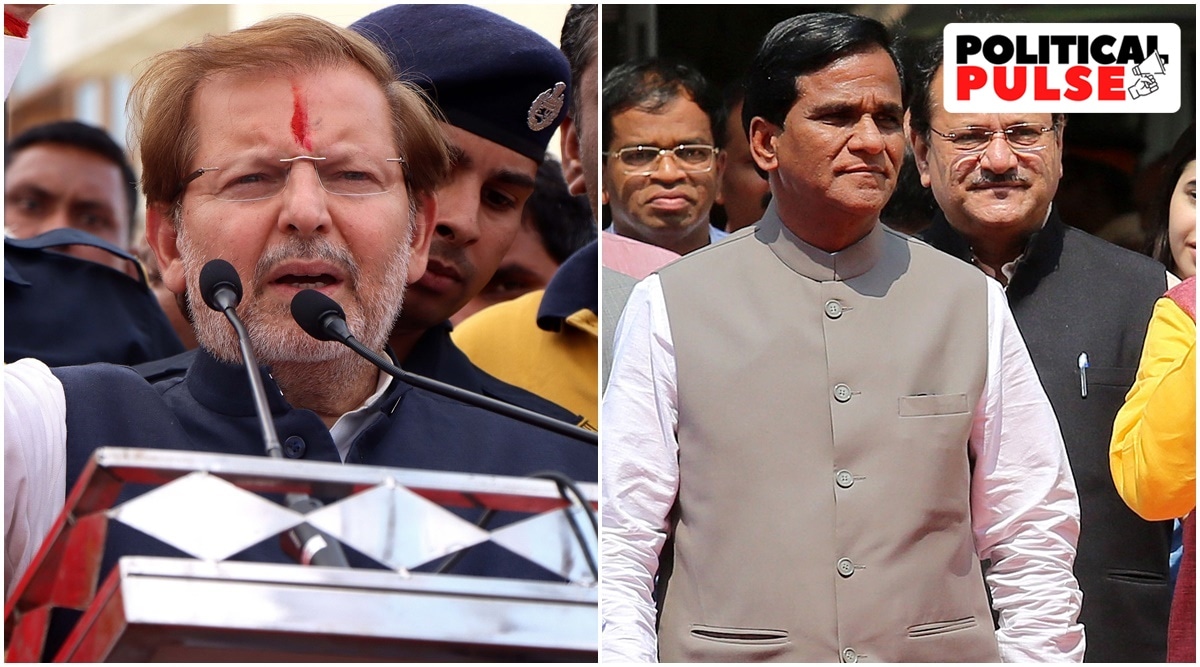 BJP leader Arvind Sharma and former Maharashtra BJP president Raosaheb Danve. (Express file)
BJP leader Arvind Sharma and former Maharashtra BJP president Raosaheb Danve. (Express file)Speaking at a Brahmin meeting recently, BJP leader and four-time Lok Sabha MP Arvind Sharma pitched for a Brahmin Chief Minister in Haryana. “There was a time when there were Brahmin CMs in 10 of the 20-22 states,” he said.
Earlier this month, Union minister and former Maharashtra BJP president Raosaheb Danve said: “I don’t want to see Brahmins just as municipal councillors or council presidents. I want to see a Brahmin holding the post of CM of this state.”
Sharma and Dave voiced a sentiment shared by many leaders belonging to the Brahmin community, which is seeing a decline of its long-held influence in the political structure of the country, despite constituting less than 10 per cent of India’s population.
While the recent calls might have come from Haryana and Maharashtra, nowhere is this lament felt more strongly than in Uttar Pradesh, the most populous and politically significant state, where with just 12% of the population, Brahmins had seen eight from within the community become chief ministers till 1989 (a period of roughly 40 years).
Best of Express Premium
The rise of Mandal politics ended that run, and in the shake-up since, the possibility of a Brahmin taking over as CM of either UP (or caste-bound Bihar) is remote in the near future.
What is fuelling resentment within the community now is the strengthening of power around CM Yogi Adityanath, a Thakur, in the state. While talk of a Brahmin rift from the BJP on account of a “pro-Thakur” Adityanath regime ended with the recent results, tensions remain.
Says a BJP leader: “Brahmins in Uttar Pradesh may not be in high numbers, but the community’s influence is high. Even Akhilesh Yadav (of the Samajwadi Party) and Mayawati (BSP) could come to power only after they crafted a political strategy to woo the Brahmins… Even Prime Minister Narendra Modi’s attempts from 2014 have been on the same lines.”
That is not how it looks to the Brahmin community, which sees the BJP itself changing colours from dependence on Hindutva and upper castes, to aggressively wooing the OBC votes. In fact, of its 12 CMs across the country, only one, Himanta Biswa Sarma of Assam, is a Brahmin.
While the last time the NDA was in power at the Centre, under A B Vajpayee, there were no Brahmin BJP CMs, the party had a handful of CMs in all. Plus, as a BJP leader points out, “Vajpayee was a Brahmin and it balanced the party’s outreach to the OBCs and Dalits. Today, Prime Minister Narendra Modi first rose as a Hindutva figure — the leader of all Hindus altogether. However, the strenuous efforts by the BJP to bring in OBCs and Dalits has been chipping away at that image.” Modi himself has taken to referring to his OBC origins.
The party’s Brahmin leaders believe that the party might be becoming too accommodating of OBCs and Dalits in a bid to spread its reach. As the leader says, “Those among the backward groups who become ministers or get positions, after all, belong to a generation that has never faced discrimination or poverty.”
In the case of UP, another leader says, “Party leaders view non-Jatav Dalits (or, the Dalits who are not the BSP’s core base) and non-Yadav OBCs (who associate the Samajwadi Party with Yadavs) as their main target support base. They think if the party can win their support, we will be comfortable for at least 10 years.”
However, the BJP too has a sense of the discontent within the Brahmin community. Before the recent Assembly elections, a committee was appointed to meet Brahmin leaders across the state, to give feedback to the RSS. It met around 40 Brahmin leaders, and suggested ways to address the community’s issues, including ‘Ekatma Samvad (discussions seeking to “reach out to the last person in the row”)’ followed by a Samajik Samvad.
“There were complaints from community leaders that the Chief Minister did not listen to them. And that the party was playing too many cards to woo the OBCs and Dalits. Their argument was that they had supported the BJP, and now that it was in power, it was ignoring them for others,” says a party leader who worked closely with the BJP central leadership for the UP elections. According to the leaders, the initiatives launched by the BJP like Ekatma Samvad then reached out to the community, especially the youth, and showcased the works done by the BJP government.
In the Assembly elections that followed, the BJP fielded 68 Brahmin candidates, the highest chunk among upper castes.
Brahmins also have increased representation in the Adityanath 2.0 government compared to 1.0 — though at least three Brahmin leaders of the BJP told The Indian Express that it was Modi who was instrumental in this.
The Adityanath Cabinet now has eight Brahmin ministers, two more than Thakurs — Brijesh Pathak (Deputy CM), Jitin Prasada, Yogendra Upadhayay, Dayashankar Mishra ‘Dayalu,’ Pratibha Shukla, Rajni Tiwari, Satish Sharma, and Bhumihar Brahmin Arvind Kumar Sharma.
However, as a leader points out, this automatically might not mean a revival of the Brahmin influence, and that “we have no Brahmin leaders now of the stature of Murli Manohar Joshi or Kalraj Mishra”.
Another leader says that the BJP must bear in mind that the Brahmins stick to the BJP due to the Sangh’s backing for the party and also because the Opposition makes no real attempts to win their confidence. “When any party, including the Congress, makes sincere efforts to win them back, and if there is an influential Brahmin leader in the region, the community could drift away.”
- The Indian Express website has been rated GREEN for its credibility and trustworthiness by Newsguard, a global service that rates news sources for their journalistic standards.

